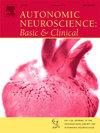降低帕金森病患者静息搏动血压变异性
IF 3.3
4区 医学
Q2 NEUROSCIENCES
引用次数: 0
摘要
目的:帕金森病(PD)是一种进行性神经退行性疾病,影响运动和非运动功能,包括自主调节。在心血管系统中,自主神经功能障碍可导致血压(BP)异常,如变异性改变。因此,本研究旨在验证PD患者比健康对照者表现出更高的静息搏动血压变异性(BPV)的假设。方法连续记录19例PD患者、15例年龄匹配的老年人和19例年轻人的搏动心率(通过心电图)和血压(通过光容积脉搏波)。采用ModelFlow方法估计心输出量(CO)和总外周阻力(TPR)。BPV采用几个指标进行评估,包括标准偏差(SD)和平均真实变异性(ARV)。结果与老年和年轻对照组相比,PD患者的收缩压(1.6±0.5 vs. 2.3±0.5和3.1±1.1 mm Hg, P = 0.001)、舒张压(0.9±0.2 vs. 1.1±0.4和1.5±0.6 mm Hg, P = 0.001)和平均血压(0.9±0.2 vs. 1.2±0.4和1.5±0.5 mm Hg, P = 0.001)的ARV值均较低。此外,与老年对照组相比,PD患者TPR的ARV降低(0.5±0.2 vs. 0.7±0.7 mm Hg/L/min, P = 0.045)。然而,PD患者与老年人CO的ARV差异无统计学意义(119±68 vs 136±48 mL/min, P = 0.806)。在使用其他BPV指数时也观察到类似的模式。这些发现表明帕金森病可能导致搏动间血压变异性的降低,这可能是由总外周阻力而不是心输出量的变化引起的。本文章由计算机程序翻译,如有差异,请以英文原文为准。
Reduced resting beat-to-beat blood pressure variability in patients with Parkinson's disease
Purpose
Parkinson's disease (PD) is a progressive neurodegenerative disorder that affects both motor and non-motor functions, including autonomic regulation. In the cardiovascular system, autonomic dysfunction may result in blood pressure (BP) abnormalities, such as altered variability. Therefore, the present study aimed to test the hypothesis that patients with PD exhibit increased resting beat-to-beat blood pressure variability (BPV) compared to healthy controls.
Methods
Beat-to-beat heart rate (via electrocardiography) and BP (via photoplethysmography) were continuously recorded in 19 patients with PD, 15 age-matched older adults, and 19 young adults. Cardiac output (CO) and total peripheral resistance (TPR) were estimated using the ModelFlow method. BPV was assessed using several indices, including the standard deviation (SD) and average real variability (ARV).
Results
Compared to both older and younger control groups, patients with PD exhibited lower ARV values for systolic (1.6 ± 0.5 vs. 2.3 ± 0.5 and 3.1 ± 1.1 mm Hg, P = 0.001), diastolic (0.9 ± 0.2 vs. 1.1 ± 0.4 and 1.5 ± 0.6 mm Hg, P = 0.001), and mean (0.9 ± 0.2 vs. 1.2 ± 0.4 and 1.5 ± 0.5 mm Hg, P = 0.001) BP. In addition, patients with PD showed reduced ARV in TPR compared to the older control group (0.5 ± 0.2 vs. 0.7 ± 0.7 mm Hg/L/min, P = 0.045). However, ARV in CO did not differ significantly between PD patients and older adults (119 ± 68 vs. 136 ± 48 mL/min, P = 0.806). Similar patterns were observed when using other BPV indices.
Conclusion
These findings suggest that Parkinson's disease may lead to a reduction in beat-to-beat blood pressure variability, potentially driven by changes in total peripheral resistance rather than cardiac output.
求助全文
通过发布文献求助,成功后即可免费获取论文全文。
去求助
来源期刊
CiteScore
5.80
自引率
7.40%
发文量
83
审稿时长
66 days
期刊介绍:
This is an international journal with broad coverage of all aspects of the autonomic nervous system in man and animals. The main areas of interest include the innervation of blood vessels and viscera, autonomic ganglia, efferent and afferent autonomic pathways, and autonomic nuclei and pathways in the central nervous system.
The Editors will consider papers that deal with any aspect of the autonomic nervous system, including structure, physiology, pharmacology, biochemistry, development, evolution, ageing, behavioural aspects, integrative role and influence on emotional and physical states of the body. Interdisciplinary studies will be encouraged. Studies dealing with human pathology will be also welcome.

 求助内容:
求助内容: 应助结果提醒方式:
应助结果提醒方式:


